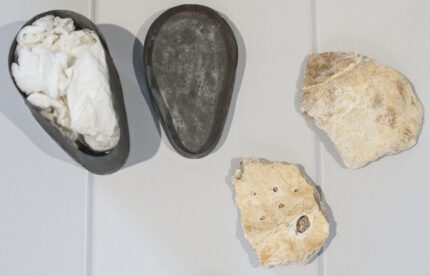
Two palm-sized and ten pea-sized fragments had broken off the skull during the autopsy performed the day after Beethoven’s death on March 26, 1827. They were buried in his coffin and buried on March 29th. In 1863, the Gesellschaft der Musikfreunde music organization arranged for Beethoven’s body (and that of Franz Schubert) to be exhumed and studied. The loose fragments were acquired at that time by Viennese physician and medical historian Franz Romeo Seligmann. Seligmann was an enthusiast of art history and phrenology and had been present at the exhumation, so he took them to make his own study of the skull of a musical genius.
The fragments remained in the family for decades, winding up in France when the family fled Nazi persecution. In 1990, US businessman Paul Kaufmann, Seligmann’s great-grand-nephew, inherited them after his mother died. He discovered the fragments in a family safety deposit box in a bank in France. They were in a metal box with “Beethoven” scratched into the lid. He loaned the fragments to the Ira F.Brilliant Center for Beethoven Studies at San Jose State University where they were studied.
Some US researchers have cast doubt on their authenticity, believing that the parts would have been damaged in a different way in the 1827 autopsy. Viennese researched in 1985 thought they were real, however, and Medical University of Vienna forensic pathologist Christian Reiter makes a strong circumstantial case that the fragments match the shape and saw grooves on the plaster cast of the skull made in 1863. The fragments also contain high concentrations of lead, something found in undisputedly authentic locks of Beethoven’s hair.
Austrian coroner Christian Reiter said the 10 fragments, including two bigger pieces, one from the back of the head and one from the right side of the forehead, had “great value”.
“We have received really valuable material here, with which we hope to continue to research in the next years. That was Beethoven’s wish too,” Reiter said.
The composer battled illness through his life and explicitly asked for his body to be studied, Reiter added.
First things first: the question of authentication will be resolved at once. DNA samples have been taken from the skull fragments by scientists at the Max Planck Institute for Evolutionary Anthropology in Leipzig. The results will be compared to the DNA retrieved from the locks of Beethoven’s hair. By the end of the year, the question should be conclusively answered.
* This article was originally published here








No comments:
Post a Comment